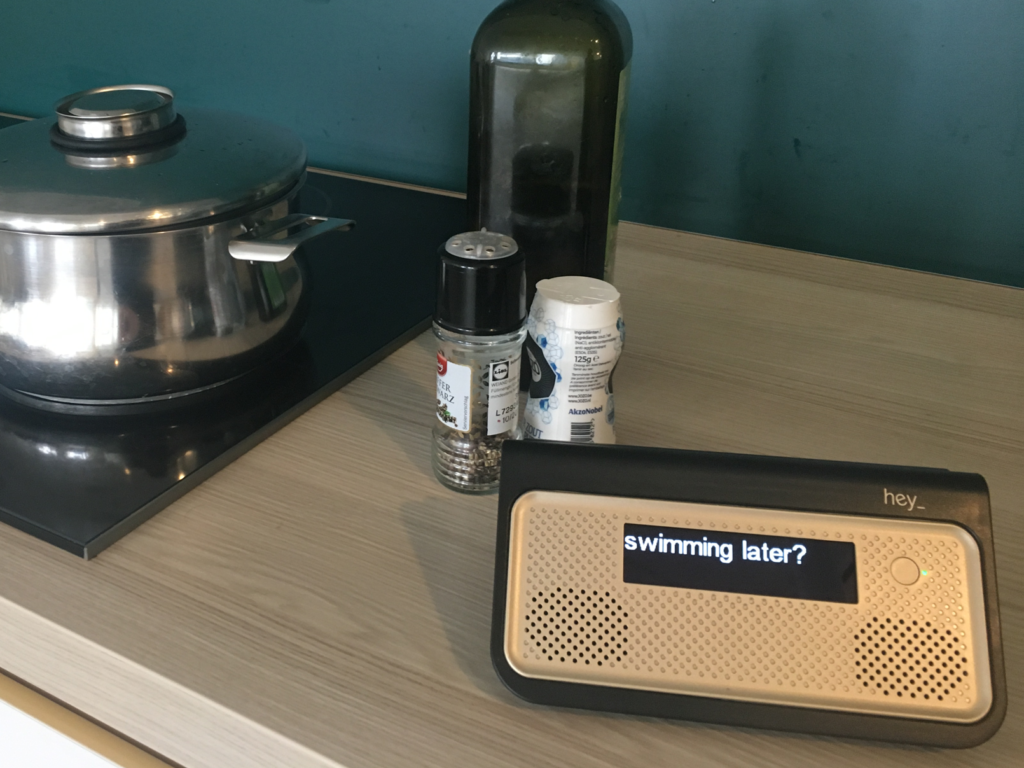Your freedom and your personality start with the ability to say what you want, feel and think. Unfortunately, speaking is not an easy task for everyone. Thanks to the evolution of speech technology, more and more (diverse) solutions are possible. Although speech technology is not on the same level as spoken communication, we aim to close the gap.
We don’t always consider how much freedom natural communication offers. You choose what you say, how you say something when you say something and to whom. Communication is not only practical, but it is also essential to be part of society. As described in the Universal Declaration of Human Rights, communication is a fundamental right. Janice Light even claims that communication is the essence of human life. You build social relationships through communication, you can express what you want to your environment. However, this is not apparent for everyone. When you use tools to communicate, we speak of Augmentative and Alternative Communication (AAC).
“The silence of speechlessness is never golden. We all need to communicate and connect with each other—not just in one way, but in as many ways as possible. It is a basic human need, a basic human right. And more than this, it is a basic human power.” (Williams, 2000, p. 248)
More than just voice output
Thanks to developments in speech technology, AAC tools are evolving and varying more. On the one hand, they make a wide range of communication channels available to the AAC user, such as social media and access to additional information technology (Williams et al., 2012). On the other hand, tools make speech technology more similar to spoken communication, such as voice banking, to be able to use your voice as a voice output. Another example is the ambition to make speech devices as light as possible in a modern design. In this way, you are more prone to using your speech computer, your voice.
A speech device is more than speech output. It’s all about saying what you want, how you want it, when and to whom you want to say something to. With a speech device, you can claim your voice in a conversation. A message box that captures the composed message ensures that an AAC user can address the desired message to whom and when they want it.
Sender – Message – Channel – Receiver
Although independent communication is possible thanks to a “voice computer”, it remains more difficult than natural communication. Both AAC and spoken communication can be traced back to the communication model of Shannon and Weaver. Their model supports the fact that a sender, a message, a channel and a receiver are essential to communicate.
We have to focus on these different elements if we want to narrow the gap between supported communication and natural communication. It is, therefore, encouraging to see that in recent years more emphasis has been placed on evidence-based content (message), qualitative technological developments (channel) and ease of conversation (receiver). In this article, we focus on the receiver.
“The success of the interaction depends not only on the skills of this individual, but also on those of the communication partner.” (Kent-Walsh & McNaughton, 2005, p. 195)
Although the role of the communication partner is important in supported communication, we do not always pay attention to it. For example, only 15% of the articles published in the AAC Journal refer to interventions with communication partners (McNaughton & Light, 2015). If we zoom in on the role of a receiver, we can distinguish two elements. You have to receive the message on the one hand and understand the message on the other.
Multimodal communication: a second display
 By using AAC, you may sometimes encounter the volatility of the spoken word. Is there a lot of noise? Or did you have a tiring day and your attention slackens for a while, so you have not fully understood someone’s carefully composed message? Multimodal communication can provide a solution. The more channels, the easier it is to understand a message. A nice way to do this is to have a second display. This is a screen on which the conversation partner can read the spoken text. As a communication partner, you can then count on your ears and your eyes. You can listen and read to what is being said. Also, the mere fact that you are facing each other makes face-to-face interaction and non-verbal communication possible (gaze direction, facial expressions, natural gestures…). Both are an essential part of our total communication. This increases the chance of a successful interaction, which is, of course, the main goal. Besides, there are many other advantages.
By using AAC, you may sometimes encounter the volatility of the spoken word. Is there a lot of noise? Or did you have a tiring day and your attention slackens for a while, so you have not fully understood someone’s carefully composed message? Multimodal communication can provide a solution. The more channels, the easier it is to understand a message. A nice way to do this is to have a second display. This is a screen on which the conversation partner can read the spoken text. As a communication partner, you can then count on your ears and your eyes. You can listen and read to what is being said. Also, the mere fact that you are facing each other makes face-to-face interaction and non-verbal communication possible (gaze direction, facial expressions, natural gestures…). Both are an essential part of our total communication. This increases the chance of a successful interaction, which is, of course, the main goal. Besides, there are many other advantages.
For example, the conversation partner no longer has to manoeuvre behind the wheelchair or within earshot. Consequently, your dialogue goes a lot smoother. The person or sender is more central instead of the speech device, thus more similar to natural communication. Furthermore, participation in society is easier. Just think about the challenge of asking for something at a counter or paying at a cash desk in the supermarket. The person on the other side of the counter can easily read the second display if they have not sufficiently understood the message.
Ease of conversation: portable second display
 There is no doubt that the sender and receiver must be within earshot for personal communication. We don’t always think about how often we want to say something to a person who is just out of earshot. Suppose that you want to say something in the car but you and your speech device are sitting in the back seat? Or if you want to say something from the living room to a loved one who is making a noise with the cooking pots in the kitchen?
There is no doubt that the sender and receiver must be within earshot for personal communication. We don’t always think about how often we want to say something to a person who is just out of earshot. Suppose that you want to say something in the car but you and your speech device are sitting in the back seat? Or if you want to say something from the living room to a loved one who is making a noise with the cooking pots in the kitchen?
For this purpose, a “portable voice” was developed in 2013: a portable second display with strong speakers. The result is that as a conversation partner you can read and hear the story, even if you are not in the same room. This allows the AAC user to claim his or her voice. You no longer have to wait until someone is in the same room. This makes it easier to ask whether you are getting ice cream or if you will go swimming later. Even in a classroom situation, the teacher can read and answer the questions via a portable second display on the teacher’s desk.
Conclusion
There is still a great deal of work to be done to ensure that AAC is more aligned with spoken communication. Although they may perhaps never be on the same level, it is reassuring to know that there are research, evolution and development in terms of the message, channel and receiver. A second (portable) display makes it considerably easier to receive and understand a message so we can also become better conversation partners.
Sources
Higginbotham, J. & Wilkins, D. (2009). In-Person Interaction in AAC: New Perspectives on Utterances, Multimodality, Timing, and Device Design. Perspectives on Augmentative and Alternative Communication, 18(4), 154 – 160.
Kent-Walsh, J. & McNaughton, D. (2005). Communication Partner Instruction in AAC: Present Practices and Future Directions, Augmentative and Alternative Communication, 21(3), 195-204.
Light, J. (1997). “Communication is the essence of human life”: reflections on communicative competence. Augmentative and alternative communication, 13 (2), 61-70.
Light, J. (2019). Challenges and opportunities in augmentative and alternative communication: Research and technology development to enhance communication and participation for individuals with complex communication needs. Augmentative and Alternative Communication, 35 (1), 1-12.
Light, J., & McNaughton, D. (2014). Communicative competence for individuals who require augmentative and alternative communication: A new definition for a new era of communication?. Augmentative and Alternative Communication, 30(1), 1-18.
Loncke, F., Campbell, J., England, A. & Haley, T. (2009). Multimodality: a basis for augmentative and alternative communication–psycholinguistic, cognitive, and clinical/educational aspects, Disability and rehabilitation, 28(3), 169 – 174.
McNaughton, D., & Light, J. (2015). What we write about when we write about AAC: The past 30 years of research and future directions. Augmentative and Alternative Communication, 31, 261–270.
Shannon, C. E., & Weaver, W. (1949). The mathematical theory of communication. Urbana, University of Illinois Press.
The Universal Declaration of Human Rights, United Nations.
Williams, B. (2000). More than an exception to the rule. In M. Fried-Oken & H. Bersani (Eds.), Speaking up and spelling it out: Personal essays on augmentative and alternative communication, 245 – 254. Baltimore, MD: Paul H. Brookes.
Williams, M. B., Beukelman, D., & Ullman, C. (2012). AAC text messaging. Perspectives on Augmentative and Alternative Communication, 21(2), 56–59.


